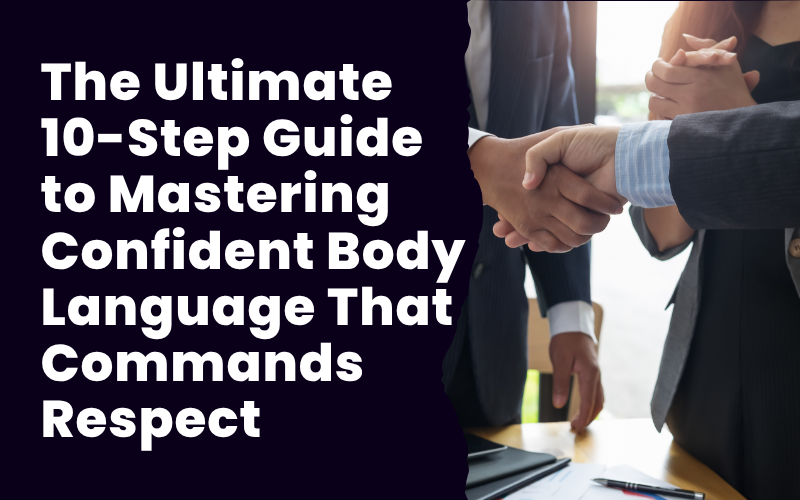Confident body language is your secret weapon in every interaction, whether you’re walking into a boardroom, meeting someone new, or simply navigating daily life. The way you carry yourself speaks volumes before you even say a word, and mastering this silent communication can transform how others perceive and respond to you.
Why Your Body Language Matters More Than You Think
Your body language accounts for 55% of all communication, according to research by Albert Mehrabian. That means more than half of what you’re “saying” has nothing to do with your actual words. When your confident body language aligns with your message, people naturally gravitate toward you, trust you more, and see you as a leader.
Think about the last time you met someone who immediately commanded attention when they walked into a room. Chances are, it wasn’t just their outfit or their words – it was their presence, their posture, their energy. That’s the power of confident body language at work.
The Foundation: Perfect Your Posture
Your posture is the cornerstone of confident body language. When you stand tall with your shoulders back and your head held high, you’re sending a clear message: “I belong here, and I’m worth listening to.”
The Power Pose Technique
Before any important meeting or event, spend two minutes in a “power pose” – stand with your feet shoulder-width apart, hands on your hips, chest open, and chin slightly raised. Research by Amy Cuddy shows this simple practice can increase confidence hormones by 20% and decrease stress hormones by 25%.
Common Posture Mistakes to Avoid:
- Hunching shoulders forward
- Looking down at your phone constantly
- Crossing arms defensively
- Shifting weight from foot to foot
Eye Contact: The Window to Confidence
Confident body language starts with your eyes. Maintaining appropriate eye contact shows you’re engaged, trustworthy, and self-assured. The key is balance – too little eye contact makes you seem disinterested or insecure, while too much can feel aggressive.
The 50/70 Rule
Maintain eye contact for 50% of the time when speaking and 70% when listening. This creates a natural rhythm that feels comfortable for both parties while demonstrating your confident body language.
When speaking to groups, practice the “lighthouse technique” – slowly sweep your gaze across the room, making brief eye contact with different individuals. This makes everyone feel included and showcases your confident body language to the entire audience.
Gestures That Amplify Your Message
Your hands are powerful tools for expressing confident body language. The right gestures can emphasize your points, show enthusiasm, and make you appear more charismatic and trustworthy.
Effective Confident Gestures:
- Open palms when explaining or offering ideas
- Steepling fingers when making important points
- Using hand movements that match your words
- Keeping gestures within the “box” between your shoulders and waist
Research from the University of Chicago found that people who use purposeful hand gestures are perceived as more powerful and confident. Your gestures should feel natural and support your message, not distract from it.
The Art of Strategic Space
How you use space around you is a crucial element of confident body language. Confident people aren’t afraid to take up space – they use it strategically to command attention and show their self-assurance.
Claiming Your Space
When sitting, avoid making yourself smaller by crossing your legs tightly or hunching over. Instead, sit with your feet flat on the floor, lean slightly forward when engaged, and use the full width of your chair. This demonstrates confident body language while showing you’re present and engaged.
In standing conversations, maintain an appropriate distance – about arm’s length for professional interactions. This respects personal boundaries while showing you’re comfortable and confident in the interaction.
Your Voice: The Audio Component of Confident Body Language
While we often think of body language as purely visual, your voice is an integral part of how you present yourself. Confident body language extends to how you use your voice – the pace, tone, and volume all contribute to your overall presence.
Speaking with Confidence:
- Lower your voice slightly for more authority
- Speak slowly and clearly
- Use pauses strategically for emphasis
- Avoid uptalk (ending statements like questions)
According to research from UCLA, vocal tone accounts for 38% of communication effectiveness. When your vocal confidence matches your physical confident body language, you create a powerful, cohesive presence.
Reading the Room: Adapting Your Confident Body Language
True confidence comes from being adaptable. The most successful people adjust their confident body language to match the situation while maintaining their core presence and authenticity.
Professional Settings
In business environments, your confident body language should be polished and purposeful. This means:
- Firm handshakes with appropriate eye contact
- Sitting up straight in meetings
- Using deliberate, controlled gestures
- Maintaining professional boundaries while being approachable
Social Situations
In casual settings, your confident body language can be more relaxed while still showing self-assurance:
- Open, welcoming posture
- Genuine smiles and expressions
- Mirroring others’ energy levels appropriately
- Using touch sparingly but meaningfully (like a pat on the shoulder)
The Confidence-Building Mirror Technique
One of the most effective ways to develop confident body language is through practice. Set aside time each day to practice your posture, expressions, and gestures in front of a mirror.
Daily Practice Routine:
- Stand in your power pose for 2 minutes
- Practice maintaining eye contact with yourself
- Rehearse key phrases with appropriate gestures
- Work on your genuine smile
- Check your posture from different angles
This isn’t about vanity – it’s about building muscle memory so your confident body language becomes natural and automatic.
Advanced Confident Body Language Techniques
Once you’ve mastered the basics, these advanced techniques can take your presence to the next level:
The Confidence Cascade
Start each interaction with one strong confident body language element – perhaps a firm handshake or direct eye contact. Let this initial confidence build throughout the conversation, adding layers of assured posture, purposeful gestures, and engaged listening.
Strategic Vulnerability
Counterintuitively, showing controlled vulnerability can actually enhance your confident body language. A slight head tilt when listening, or occasionally touching your heart when speaking about something meaningful, shows you’re confident enough to be genuine.
Common Confident Body Language Mistakes to Avoid
Even when we’re trying to project confidence, certain habits can undermine our efforts:
The Overcompensation Trap Trying too hard to appear confident can backfire. Overly aggressive gestures, maintaining uncomfortable levels of eye contact, or invading personal space can make you seem arrogant rather than confident.
Inconsistent Messaging When your body language doesn’t match your words, people notice. If you’re saying you’re excited about a project while your arms are crossed and you’re looking away, your confident body language is contradicting your message.
Neglecting Cultural Differences What reads as confident body language in one culture might be inappropriate in another. Be aware of cultural norms around eye contact, personal space, and gestures, especially in professional settings.
Building Long-Term Confident Body Language Habits
Developing truly confident body language isn’t about perfecting a performance – it’s about building genuine confidence that naturally expresses itself through your physical presence.
The Confidence-Competence Loop As you practice confident body language, you’ll likely notice that you actually feel more confident. This creates a positive feedback loop where your improved posture and presence boost your self-assurance, which in turn makes your confident body language even more natural and authentic.
Consistency is Key Make confident body language a daily practice, not something you only think about during important meetings. The more you embody these principles in everyday interactions, the more natural they become.
Your Next Steps to Mastering Confident Body Language
Start with one element of confident body language and practice it consistently for a week. Whether it’s improving your posture, making better eye contact, or using more purposeful gestures, focus on building one habit at a time.
Remember, confident body language isn’t about being perfect – it’s about being present, authentic, and self-assured. When you combine good posture, appropriate eye contact, purposeful gestures, and genuine engagement, you create a presence that naturally draws people in and commands respect.
The journey to mastering confident body language is ongoing, but every small improvement compounds to create a more powerful, influential presence. Start today, be patient with yourself, and watch how the world begins to respond to your newfound confidence.
Sources:





Pingback: How to Communicate Clearly: 7 Powerful Ways to Express Your Thoughts Like a Pro - Lady Vibe Style